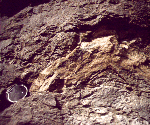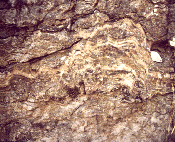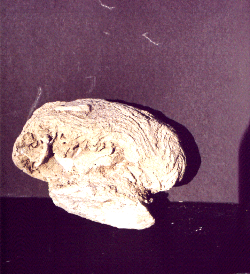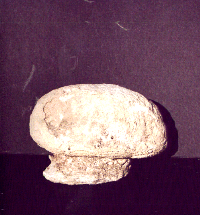Stromatoporoid
Age: Silurian
Formation: Thornloe

 Stromatoporoids range from the Cambrian to the Cretaceous. They were widespread in North America. To the left and right, you can see examples of stromatoporoid insitu. Until recently, these important reef builders from the Silurian and Devonian were classed in the Cnidarians. They are currently grouped with the sponges in the Phylum Porifera, but their placement is still under heavy debate. They are massive, encrusting or cylindrical. In the massive and encrusting genera, the surface may be covered with small groves that form a radiating rootlike pattern.
Stromatoporoids range from the Cambrian to the Cretaceous. They were widespread in North America. To the left and right, you can see examples of stromatoporoid insitu. Until recently, these important reef builders from the Silurian and Devonian were classed in the Cnidarians. They are currently grouped with the sponges in the Phylum Porifera, but their placement is still under heavy debate. They are massive, encrusting or cylindrical. In the massive and encrusting genera, the surface may be covered with small groves that form a radiating rootlike pattern. Most stromatoporiods have a layered structure, as can be seen in the cross-section of a stromatoporiod to the right. The skeleton consists of separate or joined horizontal elements. The average diameter of skeletal masses is only 4 inches (102mm), but they may grow to several meters wide. Identification of stromatoporoids to genus level requires specialized techniques that need not be reiterated in a project of this nature. Below, we see an interesting specimen in the shape of a mushroom. This shape probably occured to allow for improved water flow beneath the organism and for better potential to feed.
Most stromatoporiods have a layered structure, as can be seen in the cross-section of a stromatoporiod to the right. The skeleton consists of separate or joined horizontal elements. The average diameter of skeletal masses is only 4 inches (102mm), but they may grow to several meters wide. Identification of stromatoporoids to genus level requires specialized techniques that need not be reiterated in a project of this nature. Below, we see an interesting specimen in the shape of a mushroom. This shape probably occured to allow for improved water flow beneath the organism and for better potential to feed.


 Advance One Slide
Advance One Slide
 Go Back One Slide
Go Back One Slide